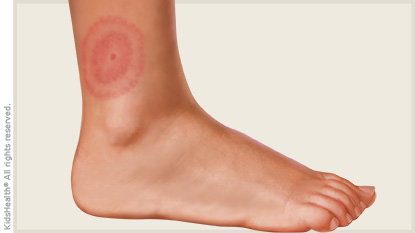- Parents Home
- Para Padres
- A to Z Dictionary
- Allergy Center
- Asthma
- Cancer
- Diabetes
- Diseases & Conditions
- Doctors & Hospitals
- Emotions & Behavior
- First Aid & Safety
- Flu (Influenza)
- Food Allergies
- General Health
- Growth & Development
- Heart Health & Conditions
- Homework Help Center
- Infections
- Newborn Care
- Nutrition & Fitness
- Play & Learn
- Pregnancy Center
- Preventing Premature Birth
- Q&A
- School & Family Life
- Sports Medicine
- Teens Home
- Para Adolescentes
- Asthma
- Be Your Best Self
- Body & Skin Care
- Cancer
- Diabetes
- Diseases & Conditions
- Drugs & Alcohol
- Flu (Influenza)
- Food & Fitness
- Homework Help
- Infections
- Managing Your Weight
- Medical Care 101
- Mental Health
- Nutrition & Fitness
- Q&A
- Safety & First Aid
- School, Jobs, & Friends
- Sexual Health
- Sports Medicine
- Stress & Coping
Lyme Disease
What Is Lyme Disease?
Lyme disease is an infection caused by a type of bacteria. The bacteria can spread to humans through the bite of an infected tick. The infection can lead to problems with the skin, heart, brain, and joints.
Treatment with antibiotics usually cures Lyme disease, especially when started early.
How Do People Get Lyme Disease?
Not all tick bites cause Lyme disease. Only deer ticks (also called black-legged ticks) can spread the bacteria that cause Lyme disease. Most U.S. cases of Lyme disease happen in Connecticut, Delaware, Maine, Maryland, Massachusetts, Minnesota, New Hampshire, New Jersey, New York, Pennsylvania, Rhode Island, Vermont, Virginia, and Wisconsin. But Lyme disease is also found in other parts of the U.S., Europe, and Asia.
Other things that might increase a person's risk include:
- spending a lot of time outdoors in tall grass, brush, shrubs, or wooded areas
- having pets that may carry ticks indoors
- activities such as yardwork, hiking, camping, fishing, or hunting in tick-infested areas
Luckily, most people bitten by deer ticks don't get Lyme disease. That's because only a small number of the ticks are infected and they must be attached to a person for at least 1–2 days to pass the bacteria.
What Are the Signs & Symptoms of Lyme Disease?
Some people don’t have any symptoms at all when they get infected. When symptoms do happen, they can vary from person to person and often happen in three stages:
Two Early Stages
For the first few weeks, symptoms may include:

If not treated, the infection can spread to other areas and cause:
- rashes on parts of the body not near the tick bite
- slow or irregular heartbeat
- problems with the nervous system (brain and spinal cord) including:
- damage to a facial nerve that can cause drooping (facial palsy)
- numbness in arms or legs
- mood changes
- memory problems
- neck stiffness and pain due to inflammation of the brain and spinal cord (meningitis)
Late Stage
If Lyme disease goes untreated for months, the earlier symptoms can continue. The person also can develop arthritis (a red, swollen, painful joint).
How Is Lyme Disease Diagnosed?
It can be hard for doctors to diagnose Lyme disease because:
- The tick bites and rash might not be noticed.
- Many early symptoms seem like the flu or other illnesses.
- Blood tests can only help diagnose Lyme disease later in the illness, several weeks after it started.
Doctors can diagnose early Lyme disease if they see a tick bite or the telltale rash, especially if the person lives in an area where Lyme disease is common.
To diagnose late-stage Lyme disease, doctors:
- Ask about symptoms.
- Do blood tests that look for signs of Lyme disease.
Depending on the symptoms, doctors might order other tests, such as a spinal tap, which looks at the fluid around the brain and spinal cord.
How Is Lyme Disease Treated?
Treatment depends on the stage of Lyme disease.
Treatment for early Lyme disease is antibiotics taken by mouth for 10–14 days. Someone with late Lyme disease needs antibiotics for a longer period, either taken by mouth or through an IV (intravenous) line.
What Is Post-Lyme Disease Syndrome?
Post-Lyme disease syndrome (also known as chronic Lyme disease) is when someone with Lyme disease still has symptoms after treatment with antibiotics. The symptoms are most likely caused by an autoimmune response. This is when the body's germ-fighting immune system attacks the body's own cells.
Most people with post-Lyme disease syndrome usually get better with time, but it can take months to feel well again.
Can Lyme Disease Be Prevented?
Not all cases of Lyme disease can be prevented. But you can help protect your family from tick bites. If you go into an area where ticks live, be sure to:
- Stay in the middle of the trail, instead of going through high grass or the woods.
- Wear closed shoes or boots, long-sleeved shirts, and long pants. Tuck pant legs into shoes or boots to prevent ticks from crawling up legs.
- Use an insect repellent.
- Consider treating clothing and gear with permethrin to repel ticks. When used properly, permethrin is safe for all ages. But don't use it on clothing or other material a child may suck on or chew.
- Wear light-colored clothing to help you see ticks more easily.
- Shower and wash hair after being outside to remove ticks before they attach.
How Can Parents Help?
If your child is diagnosed with Lyme disease, give the antibiotics exactly as the doctor directs. And because people can get Lyme disease more than once:
- Teach your child ways to avoid tick bites.
- Check kids regularly for ticks. If you find one, remove it right away.
